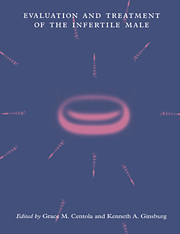Book contents
- Frontmatter
- Contents
- Preface
- List of contributors
- 1 Andrology
- 2 Sperm–egg interaction
- 3 Routine semen analysis
- 4 Computer-aided sperm analysis: a critical review
- 5 Antisperm antibodies: diagnosis and treatment
- 6 The sperm penetration assay
- 7 Intrauterine insemination for male factor
- 8 Processing human semen for insemination: comparison of methods
- 9 New assays for evaluating sperm function
- 10 Assisted reproductive technology for male factor infertility
- 11 Microinjection techniques for male infertility
- 12 Therapeutic donor insemination: screening, indications and technique
- 13 Endocrine assessment and hormone treatment of the infertile male
- 14 The urologic evaluation of the infertile male
- 15 Azoospermia: the diagnosis and treatment
- 16 White blood cells in semen and their impact on fertility
- 17 Psychological aspects of male infertility: lifting the shroud of shame
- 18 Evaluation of the female partner
- Index
13 - Endocrine assessment and hormone treatment of the infertile male
Published online by Cambridge University Press: 16 September 2009
- Frontmatter
- Contents
- Preface
- List of contributors
- 1 Andrology
- 2 Sperm–egg interaction
- 3 Routine semen analysis
- 4 Computer-aided sperm analysis: a critical review
- 5 Antisperm antibodies: diagnosis and treatment
- 6 The sperm penetration assay
- 7 Intrauterine insemination for male factor
- 8 Processing human semen for insemination: comparison of methods
- 9 New assays for evaluating sperm function
- 10 Assisted reproductive technology for male factor infertility
- 11 Microinjection techniques for male infertility
- 12 Therapeutic donor insemination: screening, indications and technique
- 13 Endocrine assessment and hormone treatment of the infertile male
- 14 The urologic evaluation of the infertile male
- 15 Azoospermia: the diagnosis and treatment
- 16 White blood cells in semen and their impact on fertility
- 17 Psychological aspects of male infertility: lifting the shroud of shame
- 18 Evaluation of the female partner
- Index
Summary
Introduction
Male factor infertility is a heterogeneous disorder. The majority of subfertile men do not have an identifiable cause of their infertility (Sokol, 1987, 1992). For example, 74% of 1041 patients seen in Melbourne, Australia, for evaluation of their infertility were diagnosed with idiopathic infertility, even though they presented with azoospermia, oligozoospermia, asthenozoospermia or normozoospermia (Baker et al., 1985). The investigators reported that as semen quality improved there was less of a chance of identifying a cause for the disturbed testicular function (Baker & Burger, 1986). Most treatment regimens for idiopathic male infertility have been unsuccessful. However, a small percentage of men will present with a clearly definable disorder that may lend itself to a therapeutic intervention. The selection of the treatment regimen depends on both the underlying endocrine abnormality and the patient's semen analysis. This chapter will review the endocrine factors leading to disordered sperm function, the evaluation needed to diagnose those conditions, and the available treatment options.
Physiology of the hypothalamic–pituitary–testicular axis
The hypothalamic–pituitary–testicular axis is a closely integrated series of closed loop feedback systems involving the higher centers in the central nervous system, the hypothalamus, the pituitary and the testicular endocrine and germinal compartments.
The hypothalamus produces gonadotropin releasing hormone (GnRH), which is transported to the pituitary gland by a short portal system connecting the two areas. Extrahypothalamic neurotransmitters, norepinephrine and dopamine, regulate GnRH synthesis and its pulsatile release into the hypophyseal portal veins. Norepinephrine facilitates GnRH secretion, while dopamine appears to have both stimulatory and inhibitory effects (Steinberger, 1979; di Zerega & Sherins, 1981).
- Type
- Chapter
- Information
- Evaluation and Treatment of the Infertile Male , pp. 194 - 214Publisher: Cambridge University PressPrint publication year: 1996



